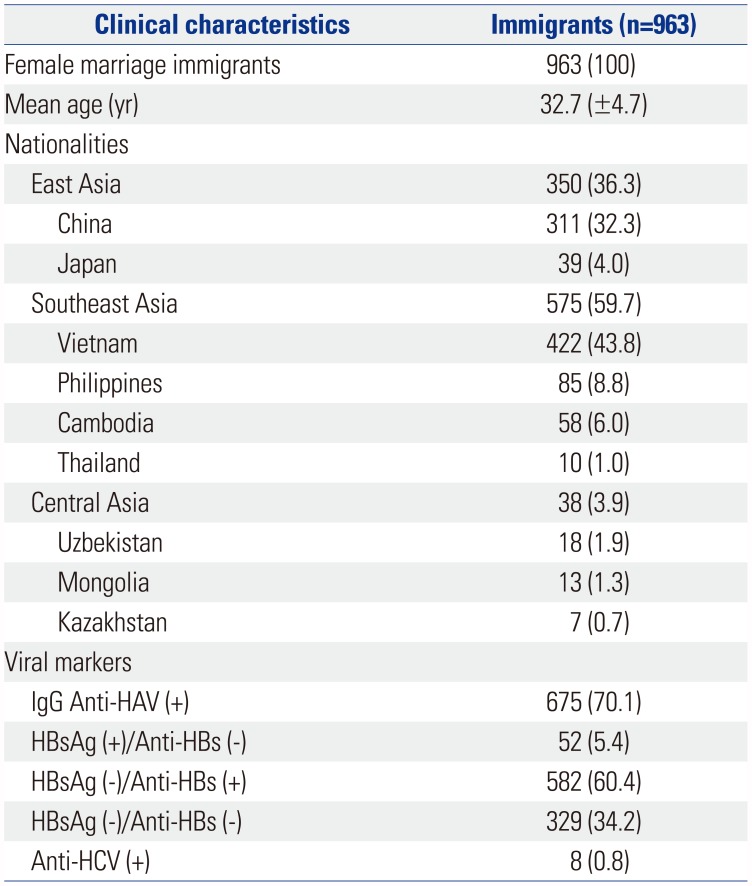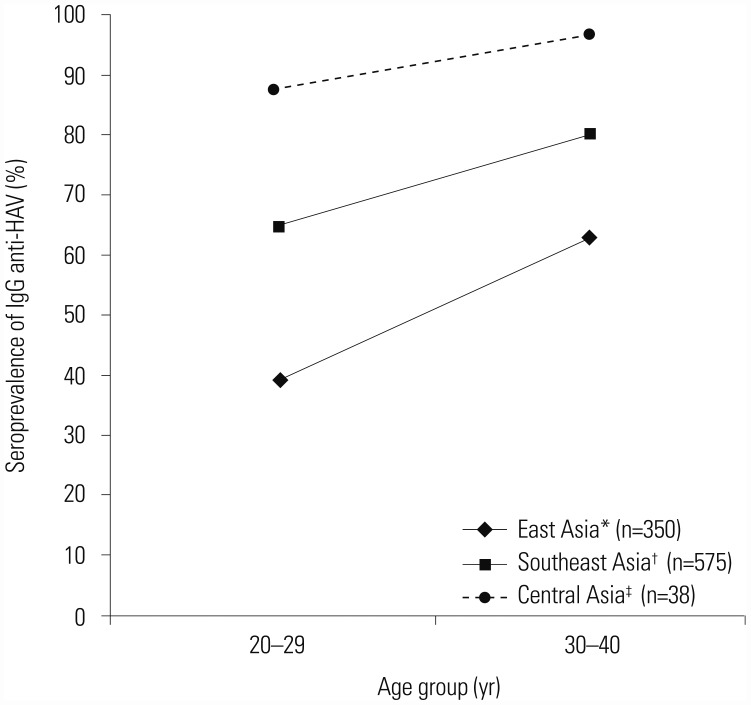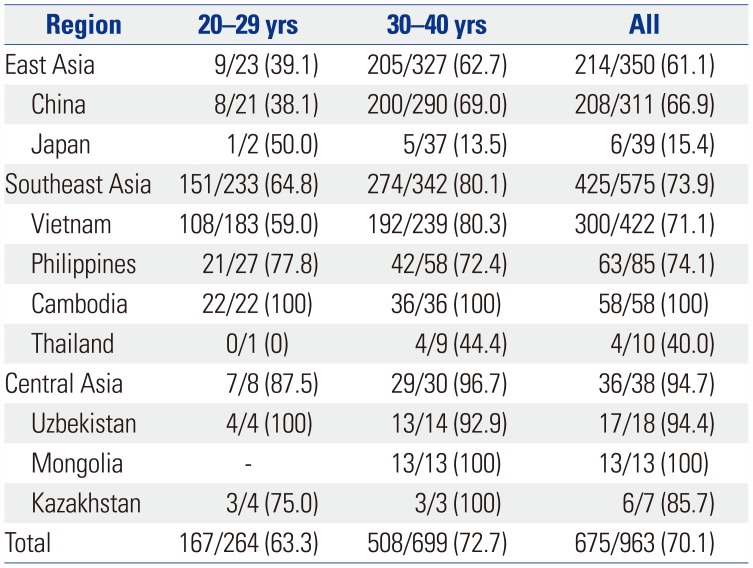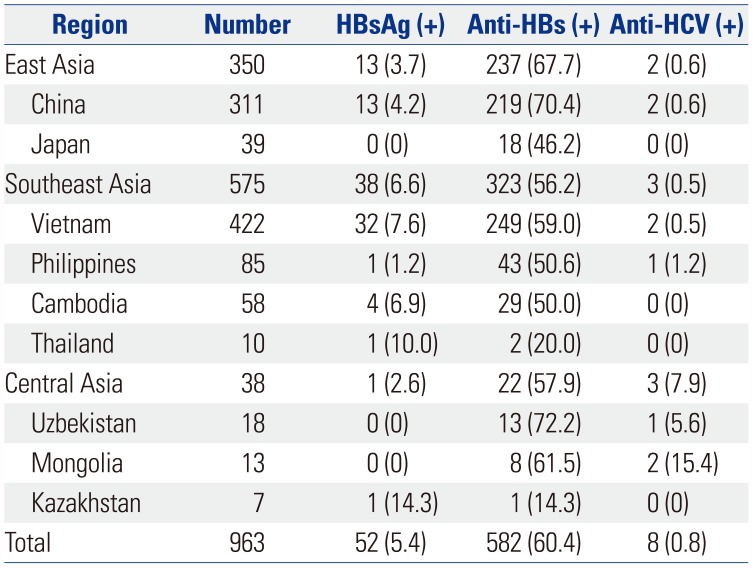2. Chae HB, Kim JH, Kim JK, Yim HJ. Current status of liver diseases in Korea: hepatitis B. Korean J Hepatol. 2009; 15(Suppl 6):S13–S24. PMID:
20037275.

3. Jazag A, Puntsagdulam N, Chinburen J. Status quo of chronic liver diseases, including hepatocellular carcinoma, in Mongolia. Korean J Intern Med. 2012; 27:121–127. PMID:
22707881.

4. Merican I, Guan R, Amarapuka D, Alexander MJ, Chutaputti A, Chien RN, et al. Chronic hepatitis B virus infection in Asian countries. J Gastroenterol Hepatol. 2000; 15:1356–1361. PMID:
11197043.

5. Nguyen VT. Hepatitis B infection in Vietnam: current issues and future challenges. Asia Pac J Public Health. 2012; 24:361–373. PMID:
21159700.
6. Sievert W, Altraif I, Razavi HA, Abdo A, Ahmed EA, Alomair A, et al. A systematic review of hepatitis C virus epidemiology in Asia, Australia and Egypt. Liver Int. 2011; 31(Suppl 2):61–80. PMID:
21651703.

7. Chung SJ, Kim TY, Kim SM, Roh M, Yu MY, Lee JH, et al. Changes in the seroprevalence of IgG anti-hepatitis A virus between 2001 and 2013: experience at a single center in Korea. Clin Mol Hepatol. 2014; 20:162–167. PMID:
25032182.

8. Jeong SH, Lee HS. Hepatitis A: clinical manifestations and management. Intervirology. 2010; 53:15–19. PMID:
20068336.

9. Lee HW, Chang DY, Moon HJ, Chang HY, Shin EC, Lee JS, et al. Clinical factors and viral load influencing severity of acute hepatitis A. PLoS One. 2015; 10:e0130728. PMID:
26090677.

10. Cho GJ, Kim YB, Kim SM, Hong HR, Kim JH, Seol HJ, et al. Hepatitis A virus infection during pregnancy in Korea: hepatitis A infection on pregnant women. Obstet Gynecol Sci. 2013; 56:368–374. PMID:
24396815.

11. Rossi C, Shrier I, Marshall L, Cnossen S, Schwartzman K, Klein MB, et al. Seroprevalence of chronic hepatitis B virus infection and prior immunity in immigrants and refugees: a systematic review and meta-analysis. PLoS One. 2012; 7:e44611. PMID:
22957088.

12. Tong MJ, Hwang SJ. Hepatitis B virus infection in Asian Americans. Gastroenterol Clin North Am. 1994; 23:523–536. PMID:
7989093.

13. Phung TB, Alestig E, Nguyen TL, Hannoun C, Lindh M. Genotype X/C recombinant (putative genotype I) of hepatitis B virus is rare in Hanoi, Vietnam--genotypes B4 and C1 predominate. J Med Virol. 2010; 82:1327–1333. PMID:
20572069.
14. Tatematsu K, Tanaka Y, Kurbanov F, Sugauchi F, Mano S, Maeshiro T, et al. A genetic variant of hepatitis B virus divergent from known human and ape genotypes isolated from a Japanese patient and provisionally assigned to new genotype J. J Virol. 2009; 83:10538–10547. PMID:
19640977.

15. Kao JH. Molecular epidemiology of hepatitis B virus. Korean J Intern Med. 2011; 26:255–261. PMID:
22016585.

16. Lin CL, Kao JH. The clinical implications of hepatitis B virus genotype: recent advances. J Gastroenterol Hepatol. 2011; 26(Suppl 1):123–130. PMID:
21199523.

17. Lee SH, Han SJ, Cho SC, Roh BJ, Sohn JH, Kim DA. Distribution of HBV genotypes in patients with chronic HBV infection in Korea. Korean J Hepatol. 2001; 7:373–380.
18. Choi MS, Kim DY, Lee DH, Lee JH, Koh KC, Paik SW, et al. Clinical significance of pre-S mutations in patients with genotype C hepatitis B virus infection. J Viral Hepat. 2007; 14:161–168. PMID:
17305881.

19. Gower E, Estes C, Blach S, Razavi-Shearer K, Razavi H. Global epidemiology and genotype distribution of the hepatitis C virus infection. J Hepatol. 2014; 61(1 Suppl):S45–S57. PMID:
25086286.

20. Kim DY, Kim IH, Jeong SH, Cho YK, Lee JH, Jin YJ, et al. A nationwide seroepidemiology of hepatitis C virus infection in South Korea. Liver Int. 2013; 33:586–594. PMID:
23356674.

21. Yoon EL, Sinn DH, Lee HW, Kim JH. Current status and strategies for the control of viral hepatitis A in Korea. Clin Mol Hepatol. 2017; 23:196–204. PMID:
28942621.

22. Lee D, Cho YA, Park Y, Hwang JH, Kim JW, Kim NY, et al. Hepatitis a in Korea: epidemiological shift and call for vaccine strategy. Intervirology. 2008; 51:70–74.

23. Lee D, Ki M, Lee A, Lee KR, Park HB, Kim CS, et al. A nationwide seroprevalence of total antibody to hepatitis A virus from 2005 to 2009: age and area-adjusted prevalence rates. Korean J Hepatol. 2011; 17:44–50. PMID:
21494077.

24. Korea Centers for Disease Control and Prevention. Infectious diseases surveillance yearbook, 2015. Cheongju: Korea Centers for Disease Control and Prevention;2016.
25. Recommended immunization schedule for adults in Korea, by the Korean Society of Infectious Diseases, 2012. Clin Exp Vaccine Res. 2014; 3:110–112. PMID:
24427768.
26. Jacobsen KH, Wiersma ST. Hepatitis A virus seroprevalence by age and world region, 1990 and 2005. Vaccine. 2010; 28:6653–6657. PMID:
20723630.

27. Yun H, Lee HJ, Yoon Y, Kim K, Kim S, Shin MH, et al. Seroepidemiology of hepatitis a infection in northeastern china, Korea, and Japan. Osong Public Health Res Perspect. 2012; 3:31–35. PMID:
24159484.

28. Poovorawan K, Soonthornworasiri N, Sa-Angchai P, Mansanguan C, Piyaphanee W. Hepatitis B vaccination for international travelers to Asia. Trop Dis Travel Med Vaccines. 2016; 2:14. PMID:
28883958.

29. Avazova D, Kurbanov F, Tanaka Y, Sugiyama M, Radchenko I, Ruziev D, et al. Hepatitis B virus transmission pattern and vaccination efficiency in Uzbekistan. J Med Virol. 2008; 80:217–224. PMID:
18098129.

30. Davaalkham D, Ojima T, Uehara R, Watanabe M, Oki I, Wiersma S, et al. Impact of the universal hepatitis B immunization program in Mongolia: achievements and challenges. J Epidemiol. 2007; 17:69–75. PMID:
17545693.

31. Nurgalieva ZZ, Hollinger FB, Graham DY, Zhangabylova S, Zhangabylov A. Epidemiology and transmission of hepatitis B and C viruses in Kazakhstan. World J Gastroenterol. 2007; 13:1204–1207. PMID:
17451200.

32. Schweitzer A, Horn J, Mikolajczyk RT, Krause G, Ott JJ. Estimations of worldwide prevalence of chronic hepatitis B virus infection: a systematic review of data published between 1965 and 2013. Lancet. 2015; 386:1546–1555. PMID:
26231459.

33. Elgouhari HM, Abu-Rajab Tamimi TI, Carey WD. Hepatitis B virus infection: understanding its epidemiology, course, and diagnosis. Cleve Clin J Med. 2008; 75:881–889. PMID:
19088007.

34. Cho EJ, Kim SE, Suk KT, An J, Jeong SW, Chung WJ, et al. Current status and strategies for hepatitis B control in Korea. Clin Mol Hepatol. 2017; 23:205–211. PMID:
28942624.

35. Kim HK, Yoo SH, Cho S, Kwon EJ, Kim SY, Park JY. Health status and associated health risks among female marriage immigrants in Korea. Korean J Health Educ Promot. 2010; 27:79–89.
36. Kao JH, Chen PJ, Chen DS. Recent advances in the research of hepatitis B virus-related hepatocellular carcinoma: epidemiologic and molecular biological aspects. Adv Cancer Res. 2010; 108:21–72. PMID:
21034965.
37. McMahon BJ. The influence of hepatitis B virus genotype and subgenotype on the natural history of chronic hepatitis B. Hepatol Int. 2009; 3:334–342. PMID:
19669359.

38. Sunbul M. Hepatitis B virus genotypes: global distribution and clinical importance. World J Gastroenterol. 2014; 20:5427–5434. PMID:
24833873.

39. Petruzziello A, Marigliano S, Loquercio G, Cozzolino A, Cacciapuoti C. Global epidemiology of hepatitis C virus infection: an up-date of the distribution and circulation of hepatitis C virus genotypes. World J Gastroenterol. 2016; 22:7824–7840. PMID:
27678366.

40. Korean Women's Development Institute. The survey of current state of multicultural family in Korea. Seoul: Ministiry of Gender Equality and Family;2015.









 PDF
PDF ePub
ePub Citation
Citation Print
Print



 XML Download
XML Download